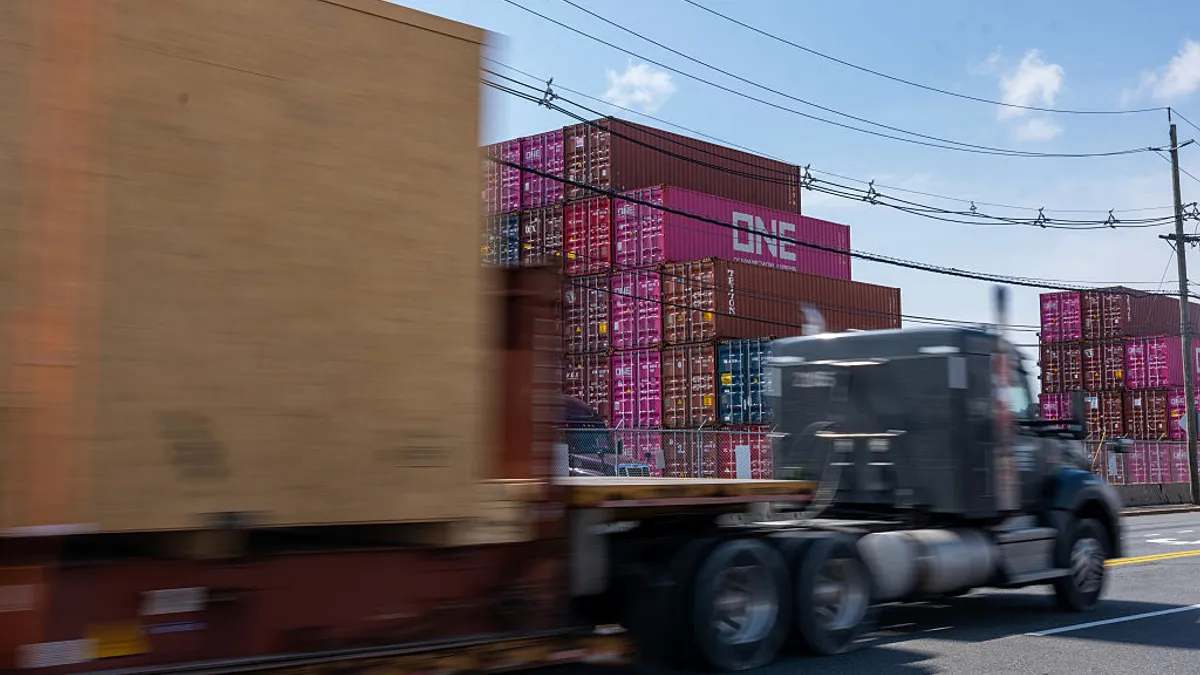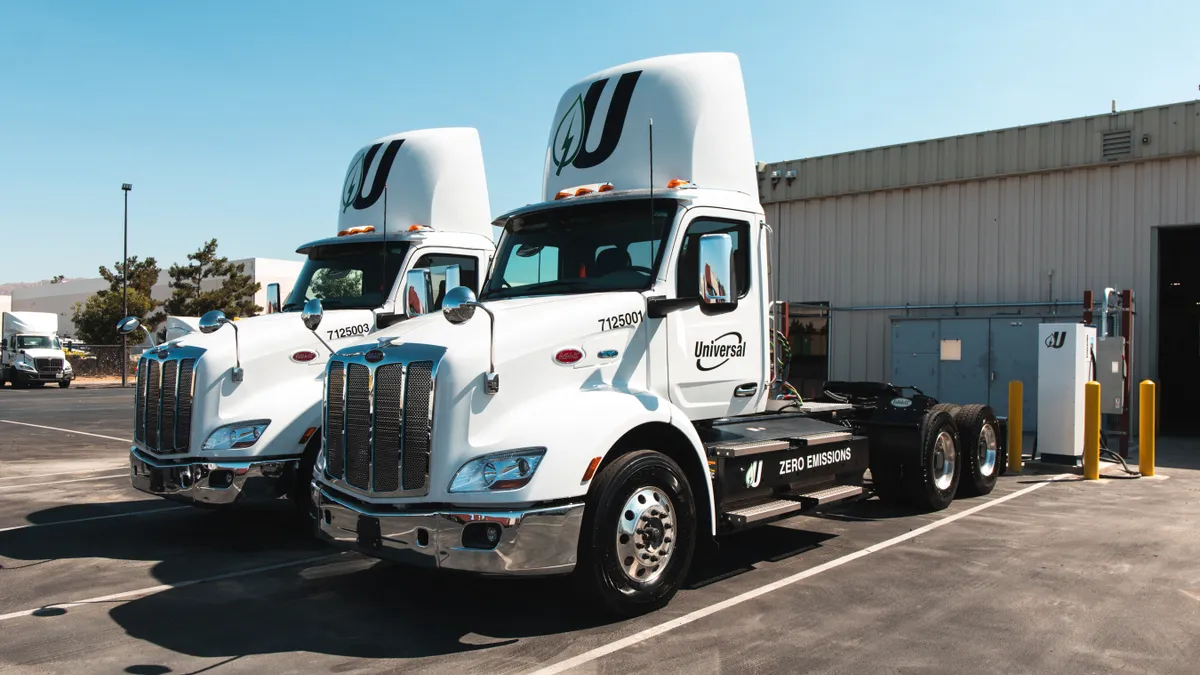The trucking industry is closely watching for any sign of a market upturn, but no inflection point is in sight yet, executives told investors and analysts on Q1 earnings calls.
Transport Dive has rounded up a handful of major trucking companies’ comments on freight demand — and what they expect in Q2 and beyond.
Together, executives painted a picture of a freight market underperforming typical spring seasonality, leading carriers to dim their expectations for a rebound in the near term.
ArcBest
The most challenging question isn’t whether freight rates are near the bottom, but how long they will remain there, Steven Leonard, ArcBest Corp. chief commercial officer and president of asset-light logistics, said on a Q1 earnings call.
ArcBest’s largest sequential jump in tonnage from Q4 to Q1 in a weak demand environment prompted an analyst to ask whether the carrier had pushed too far for volume, and sacrificed revenue per hundredweight. That metric, a measure of shipment value, notched a record drop in the same period.
CEO Judy McReynolds said accepting lower-value shipments in tough times allows it to hold onto employees longer. The carrier still hasn’t refilled all of the 1,000 jobs it cut as the pandemic reached the U.S. in March 2020, she said.
“There are several different elements here that we're trying to navigate,” McReynolds said. “One of those being we want to get these people that we've hired over the last couple of years experienced, proficient, and productive, and also ready for growth when things turn.”
Heartland Express
Heartland Express noted that its acquisitions in H2 2022 of Smith Transport and TFI International assets are seeing challenges given the freight market.
"Demand is significantly less than it has been in the last two years along with significant pressure from many shippers to reduce freight rates while operational costs continue to rise," Heartland Express CEO Mike Gerdin said in an earnings release.
The carrier projected an ongoing trend of lower freight demand and freight rate pressure to continue for one to two quarters.
Knight-Swift
Knight-Swift Transportation Holdings reported a number of projections for the freight market outlook for 2023, based on its Q1 earnings report released Thursday. Among them, the carrier forecast the following:
- Capacity continuing to exit at an accelerating rate
- Freight volumes beginning to improve in the second half of the year with a more typical peak season
- Spot pricing bottoming out in the second quarter and beginning to recover in the second half of 2023
"As the year progresses, demand should begin improving as shippers make further progress reducing inventory levels and import volumes return to more normal levels," CEO Dave Jackson said on an earnings call.
"The combination of demand recovery and supply reduction should lead to an improving freight market conditions by the end of the third quarter."
Old Dominion
Facing persistently weak demand, Old Dominion Freight Line revised its previous expectations for a Q2 freight rebound.
The carrier’s LTL tonnage per day dropped nearly 12% YoY in Q1, with April seeing a roughly 15% drop in tonnage.
“While our volumes stabilized during January and February as expected, we have not seen the acceleration in volumes that was originally anticipated,” CEO Greg Gantt said on the call.
Old Dominion is well positioned to respond to any acceleration in volumes that might occur if and when the economy improves, he said.
“Until that time comes, we will continue to focus on managing our costs and delivering value to our customers,” Gantt said.
Schneider National
A moderate freight recovery may be on the horizon in the second half of the year, but uncertainty looms, Schneider National President and CEO Mark Rourke said on a Q1 earnings call.
“The inventory positioning across many of our customers is making solid progress, but the replenishment cycle remains spotty and delayed compared to our original expectation,” Rourke said. “This dynamic has been especially evident in low import volumes, which highly correlates to the intermodal volumes. The percentage of spot freight in our asset-based network is incrementally higher than we planned for this time of year.”
Industry capacity levels are correcting but at a slower pace than the company anticipated, Rourke said. Tighter credit access may accelerate smaller carriers exiting the market, further reducing capacity.
“Those signs include owner-operator lease defaults running ahead of pre-pandemic levels, a meaningful increase in the availability of experienced driver candidates on our new driver hiring pipeline, and the overall stress in the small carrier community operating in our brokerage business as spot rates dipped below the breakeven point,” he said.
TFI International
TFI International’s negotiations with the International Brotherhood of Teamsters over a new contract at TForce Freight are happening against the backdrop of a 20% drop in volumes at the union-represented LTL unit, Chairman, President and CEO Alain Bédard said on a Q1 earnings call.
“We've been clear with them ... the volume, that's gone,” Bédard said. “It's not coming back next week. It’s not coming back next month. And we have to be more efficient.”
TFI expects demand softness to persist for the year, but it expects its financial position to improve in Q2, Q3 and Q4.
“Not because of market condition, because I don't think market condition will improve,” Bédard said. “But I think that we will do a better job at [managing] our cost.”
Yellow
Yellow Corp.’s LTL tonnage per day dropped 12% YoY in Q1, the company reported.
As it negotiates its One Yellow network overhaul with the Teamsters, the carrier will continue to protect its large and loyal customer base “until we see destocking improve somewhat,” CEO Darren Hawkins said on an earnings call.
“Once we get to the bottom of that, I believe the majority of customers out there are certainly wise to the fact that there will be a capacity challenge again, because of what all carriers have had to do during this downturn,” he said. “And also not being determinative on how long the downturn is going to last.”
XPO
XPO managed to limit the loss of LTL tonnage per day to 1.8% YoY in Q1, with its daily shipments up 1.5%.
The carrier expects headcount to continue to decline, and it expects to see the full run rate benefit of more than $50 million in annualized labor-related cost savings in Q3.
CEO Mario Harik offered investors and analysts a reason for hope: XPO outperformed typical seasonality from March to April.
“A lot of these things are company-specific, but we're seeing a slightly better demand environment in April than we did see in March,” Harik said on a Q1 earnings call.




















